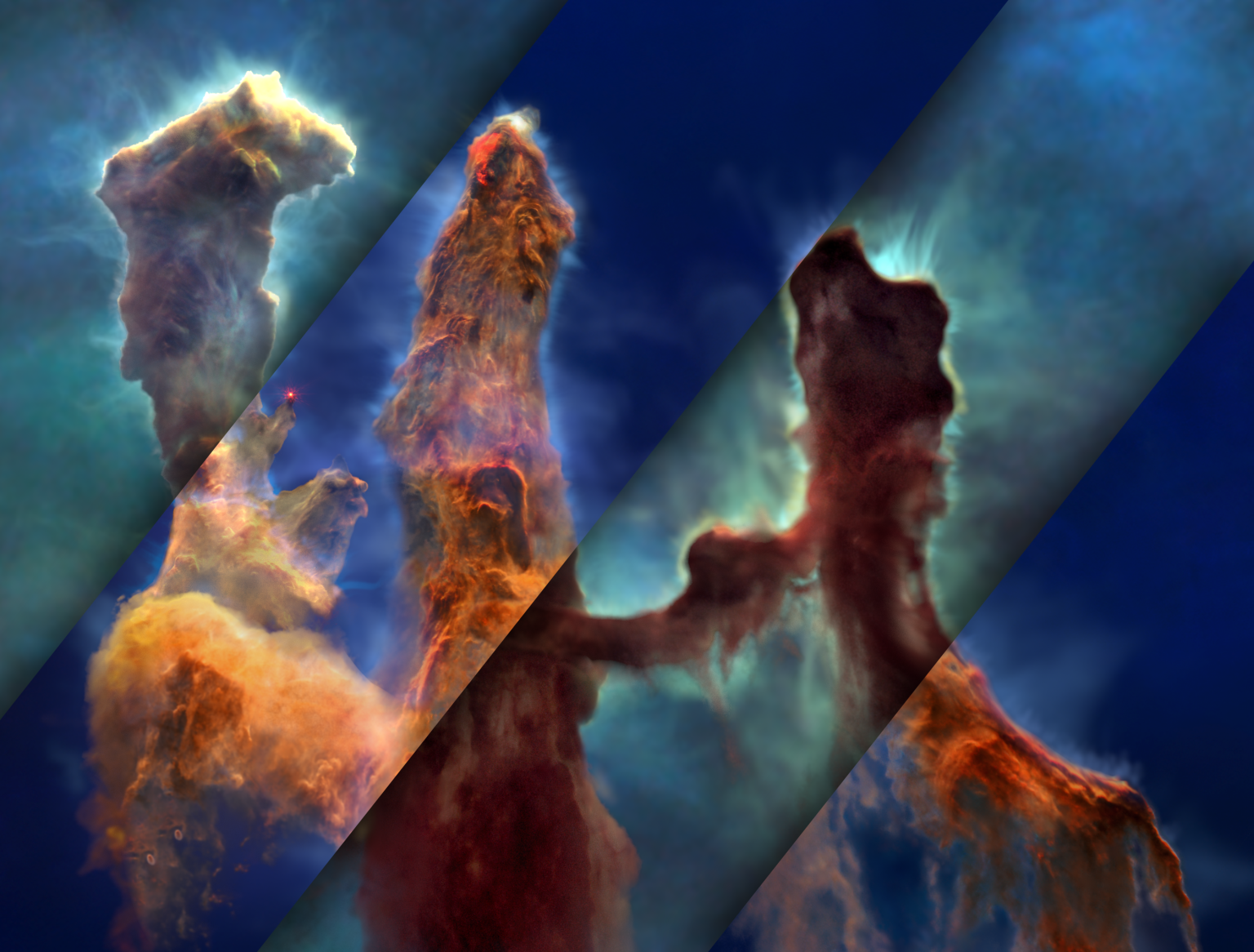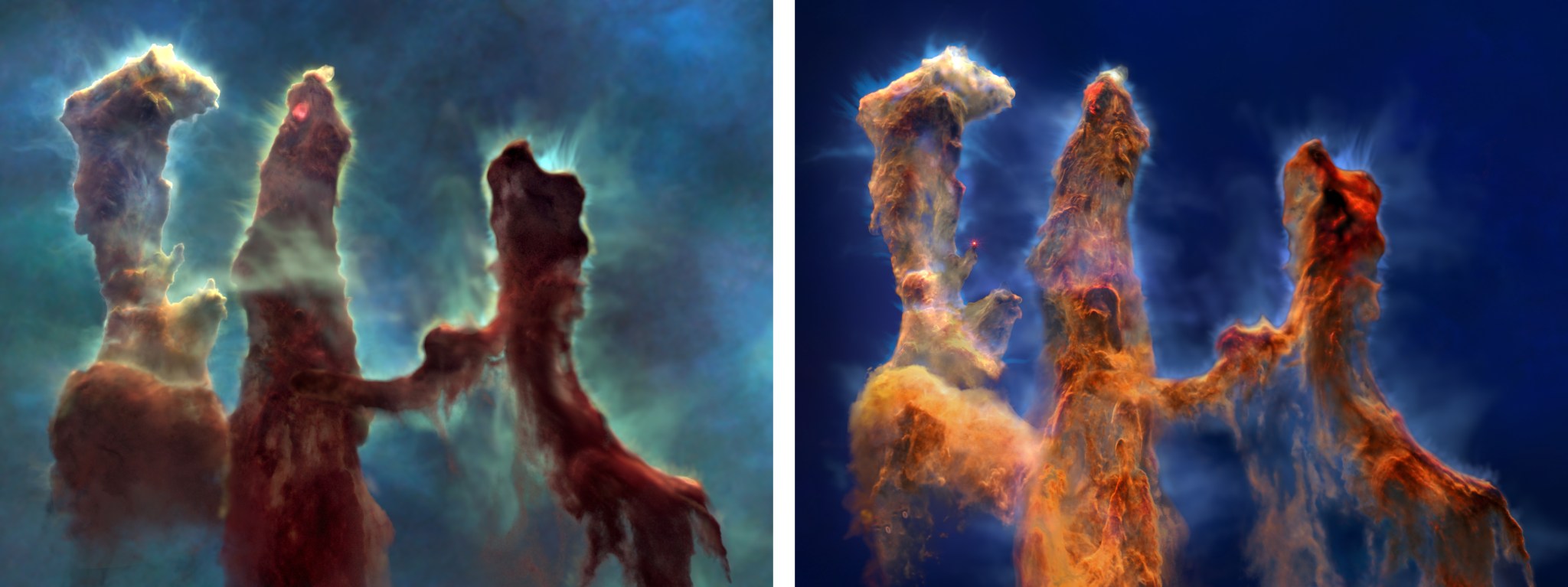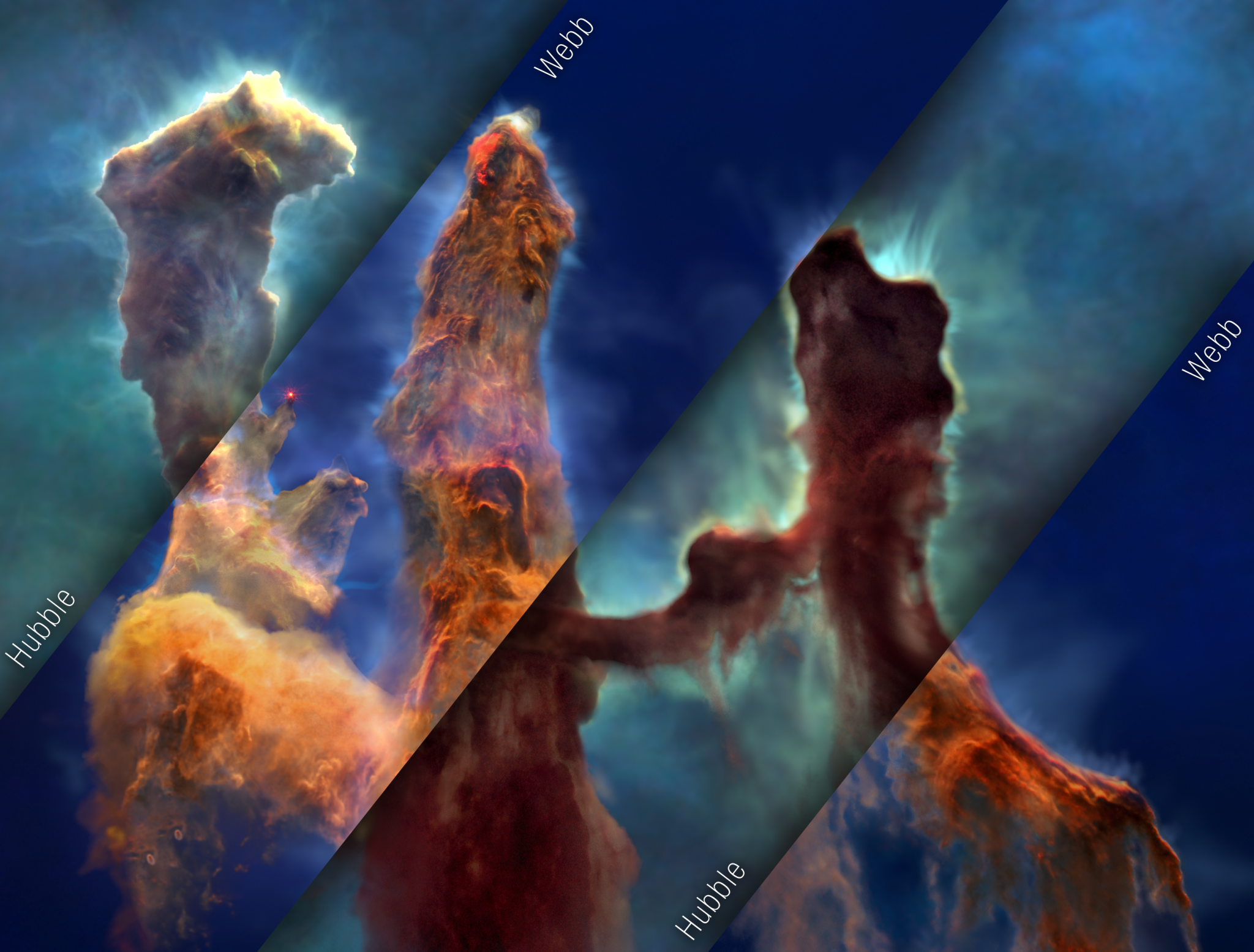
Greg Bacon, Ralf Crawford, Joseph DePasquale, Leah Hustak, Christian Nieves, Joseph Olmsted, Alyssa Pagan, and Frank Summers (STScI), NASA's Universe of Learning
Made famous in 1995 by NASA's Hubble Space Telescope, the Pillars of Creation in the heart of the Eagle Nebula have captured imaginations worldwide with their arresting, ethereal beauty.
Now, NASA has released a new 3D visualization of these towering celestial structures using data from NASA's Hubble and James Webb space telescopes. This is the most comprehensive and detailed multiwavelength movie yet of these star-birthing clouds.
"By flying past and amongst the pillars, viewers experience their three-dimensional structure and see how they look different in the Hubble visible-light view versus the Webb infrared-light view," explained principal visualization scientist Frank Summers of the Space Telescope Science Institute (STScI) in Baltimore, who led the movie development team for NASA's Universe of Learning. "The contrast helps them understand why we have more than one space telescope to observe different aspects of the same object."
Image: Hubble Model and Webb Model

The four Pillars of Creation, made primarily of cool molecular hydrogen and dust, are being eroded by the fierce winds and punishing ultraviolet light of nearby hot, young stars. Finger-like structures larger than the solar system protrude from the tops of the pillars. Within these fingers can be embedded, embryonic stars. The tallest pillar stretches across three light-years, three-quarters of the distance between our Sun and the next nearest star.
The movie takes visitors into the three-dimensional structures of the pillars. Rather than an artistic interpretation, the video is based on observational data from a science paper led by Anna McLeod, an associate professor at the University of Durham in the United Kingdom. McLeod also served as a scientific advisor on the movie project.
"The Pillars of Creation were always on our minds to create in 3D. Webb data in combination with Hubble data allowed us to see the Pillars in more complete detail," said production lead Greg Bacon of STScI. "Understanding the science and how to best represent it allowed our small, talented team to meet the challenge of visualizing this iconic structure."
Image: Pillars of Creation Visualization

The new visualization helps viewers experience how two of the world's most powerful space telescopes work together to provide a more complex and holistic portrait of the pillars. Hubble sees objects that glow in visible light, at thousands of degrees. Webb's infrared vision, which is sensitive to cooler objects with temperatures of just hundreds of degrees, pierces through obscuring dust to see stars embedded in the pillars.
"When we combine observations from NASA's space telescopes across different wavelengths of light, we broaden our understanding of the universe," said Mark Clampin, Astrophysics Division director at NASA Headquarters in Washington. "The Pillars of Creation region continues to offer us new insights that hone our understanding of how stars form. Now, with this new visualization, everyone can experience this rich, captivating landscape in a new way."
Produced for NASA by STScI with partners at Caltech/IPAC, and developed by the AstroViz Project of NASA's Universe of Learning, the 3D visualization is part of a longer, narrated video that combines a direct connection to the science and scientists of NASA's Astrophysics missions with attention to the needs of an audience of youth, families, and lifelong learners. It enables viewers to explore fundamental questions in science, experience how science is done, and discover the universe for themselves.
Several stages of star formation are highlighted in the visualization. As viewers approach the central pillar, they see at its top an embedded, infant protostar glimmering bright red in infrared light. Near the top of the left pillar is a diagonal jet of material ejected from a newborn star. Though the jet is evidence of star birth, viewers can't see the star itself. Finally, at the end of one of the left pillar's protruding "fingers" is a blazing, brand-new star.
Video: Pillars of Creation Visualization
A bonus product from this visualization is a new 3D printable model of the Pillars of Creation. The base model of the four pillars used in the visualization has been adapted to the STL file format, so that viewers can download the model file and print it out on 3D printers. Examining the structure of the pillars in this tactile and interactive way adds new perspectives and insights to the overall experience.
More visualizations and connections between the science of nebulas and learners can be explored through other products produced by NASA's Universe of Learning such as ViewSpace, a video exhibit that is currently running at almost 200 museums and planetariums across the United States. Visitors can go beyond video to explore the images produced by space telescopes with interactive tools now available for museums and planetariums.
NASA's Universe of Learning materials are based upon work supported by NASA under award number NNX16AC65A to the Space Telescope Science Institute, working in partnership with Caltech/IPAC, Pasadena, California, Center for Astrophysics | Harvard & Smithsonian, Cambridge, Massachusetts, and Jet Propulsion Laboratory, La Cañada Flintridge, California.
Explore More
Eagle Nebula Resources from NASA's Universe of Learning
Interactive: Explore the Pillars of Creation at Multiple Wavelengths
Hubble Goes High-Definition to Revisit Iconic 'Pillars of Creation'
Haunting Portrait: NASA's Webb Reveals Dust, Structure in Pillars of Creation
Hubble's Messier Catalog: The Eagle Nebula (M16)
Downloads
Hubble Model and Webb Model Image
Pillars of Creation Visualization Image
Pillars of Creation Visualization Video
All Image and Video Products for this Article






